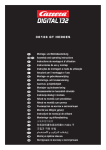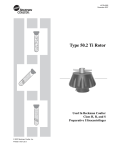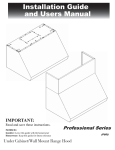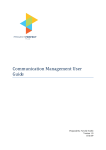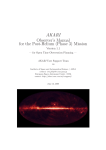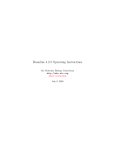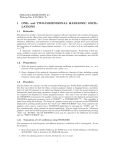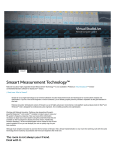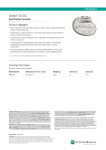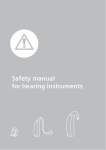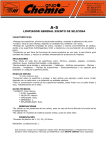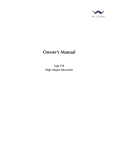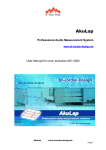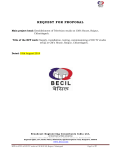Download CRS- An appraisal & demystification of the technical issues
Transcript
Community Radio Station - an appraisal and demystification of the technical issues (R.Narasimha Swamy, General Manager, Regional Office [South], BECIL, Bangalore) Abstract: Even though the rate of growth of Community Radio in India is slow, now-a-days, it is steadily getting recognized as an important communication tool for empowering the community by the Civil Society due to its inherent virtues. However, the rate of growth of CR in our country is not as expected, considering the bewildering diversity of culture, language, size etc and also most importantly the oral tradition of ours. Another important issue which has hindered the healthy growth of the CR is the technical issues concerned with its establishment and maintenance. The reasons for its slow growth are several which include appreciation of the spirit of CR and all important content and sustainability issues of the medium itself. Government and other institutions are making sincere efforts to demystify the concept of CR and successful to a great extent. Unfortunately, the technical issues are either looked as some mysterious science which can be tackled only by some “experts” or “consultants” or on its flip side, try to oversimplify or trivialize the technical issues. Both extreme postures hinder the healthy growth and sustenance of CR. The former posture leads to the exploitation of the gullible CR promoters, later one leading CR not operating to its full potential or becoming sick or defunct as many have become already. This situation has arisen due to lack of understanding or appreciation of the technical issues of Radio broadcasting viewed in perspective with the CR both by promoters of CR as well as Broadcast Engineers. This paper tries to apprise the general public about the basic technical features of CR setup, its importance, and also how to successfully setup and manage the CR within the limited resources without compromising the quality of broadcast. 1.0 Introduction. This paper discusses the essential setup, technical equipment, and its features of a CR station to provide an idea of its working for CR promoters and help them in right choice of the equipment considering their budgetary constraints. The block schematic of the equipment is provided at the end of this paper. 2.0 Location and infrastructure requirements. Considering that, FM broadcast signals are transmitted in Very High Frequency (VHF band II) from 88 MHz to 108 MHz, in which the communication takes place is strictly line of sight distances over space wave, the station needs to be located at the highest altitude within the activity zone of the NGO. In view of the convenience of the community, CRS should be located close to the populated localities but, again away from all traffic and crowd noise for obvious reasons. All contrasting requirements! If the CR promoter is an Educational institution, they have very little choice but, to setup the station within their campus. As far as space requirement is concerned, it can be as modest as two or three rooms of 200 to 300 square feet size or bigger with good height. Rooms of more than 4 sides of unequal size and angle and shape are preferred over conventional rectangular spaces. The square rooms of equal length and breadth should be avoided at all the time to prevent and exaggerate the resonance of the sound waves and resulting flutter echoes which are very difficult to control. The bigger the room it is better but, the expenses for treatment will go up proportionately. It is prefer to select the space at the higher floors as the noise from outside will be relatively less. This also helps in reducing the cost of setting up of transmission tower, as it can be erected on the roof top itself like many Mobile telephone towers, provided the roof is strong enough to take the weight of tower and its foundation. Government stipulates that the height of the tower to be not more than 30 meters from the ground level. Hence, if the building is 10 meters height, then the roof top tower will be of 20 meter height thus economizing on the cost of the tower. 2.1 Electrical supply arrangement. Ensuring reliable and clean power supply for the entire CR station is of great importance. Unfortunately, this is the most neglected segment of the CR station. Electronic equipments particularly the transmitters which employ MOSFET solid state devices in their power amplifier are susceptible to failure for transient surge voltages of the mains power supply. Surge voltages on mains can occur due to lightning, thunderstorms, discharges due to operation of HT/EHT breakers on the power system, switching transients etc. To protect the sensitive equipment against these transients, now-a-days protective devices are available. These devices can be installed in the mains power supply distribution panel. On-line good quality UPS of reputed make is a must for powering the Workstations, Audio Mixer, and Transmitters. Another important requirement of CR station is providing good earthing to electrical switchgear as well as equipments. The transmission tower has to be protected against lightning hits by providing lightning arrestor. 1 At least two separate earth pits are to be provided for the transmission tower by running separate copper strips or wire of at least 6 SWG as earth strips from the lightning arrestors to the earth pits. All the joints of the earth strip are to be brazed for continuity. Using galvanized wires or using the tower itself as conductor can lead to disastrous effects. Similarly, at least 6-8 SWG copper wire is to be provided between the electrical and RF equipments to its earth as connectivity and all connections brazed. Earth pits for the transmission tower should be different from the electrical switchgear and other equipments. It is highly advisable to provide two earth pits for transmission tower and one each for electrical and other equipments. It is understood that, all the equipments in at least three functioning CRS are totally destroyed due to lightning hits. Obviously, these stations did not have properly laid out lightning protection scheme as explained above. 3.0 Studios. Studios are the interior spaces where the production and transmission activity like playout happens. All activity of CR station take place in this place. This is the place which is visible for the community. 3.1 Studio Space requirement. Basically, at least two studios viz On-air Studio from where the transmission originates and another for recording the programs like talk, interview, group discussion take place. The recording Studio can also be utilized for recording the music items provided it is of slightly bigger size and the furniture can be organized appropriately. In addition, it is preferred if the station can have a waiting room or lounge or even open space for general purpose use. 3.2. Necessity of acoustic treatment. In any closed spaces like rooms, auditoriums, sound recording Studios etc, the sound waves undergo physical phenomenon like reflection, refraction, diffraction etc obeying the laws of Physics. Hence, the sound what one hears in a closed space is not only the direct sound but, also due to above referred physical phenomenon which cannot be wished away. Unfortunately, these phenomenon leads to unpleasant effect generally termed as echoes. (Even though actual definition of echo is totally different from the one generally understood or perceived in closed spaces) These echoes can be characterized by acousticians as flutter echoes due to resonance and standing waves caused by the parallel walls, reverberation due to multiple reflections etc. Considering the size of the rooms normally utilized in CRS, the earlier phenomenon dominates and reverberation is a characteristic of larger sized halls like Auditorium. All these phenomenon leads to coloration of the direct sound waves leading to loss of intelligibility of the spoken word spoken or recorded in such spaces. The situation can be grave for classical music due to change in the perceived pitch and coloration of the music itself. To reduce the effects of these phenomenons and also to insulate the Studios from external noises, measures like “sound proof treatment” is carried out. This treatment is basically to prevent the undesirable external sound like traffic noise, general crown noise or chatter entering the Studio and reducing the ill effects of flutter echoes to a large extent and reverberation to some extent. 3.3 Sound insulation and its effects. For propagation of sound waves, physical medium is essential. The sound we generally perceive, is the one which is propagating over all prevalent medium of air. Hence, to effectively insulate the Studios from external noise, the interior of Studios should be really made air-tight and hence, to be sealed off from the external space. This is really very difficult to achieve. Sound from even small openings of few square mm apertures like the window and door fissures, cable entries etc can allow external sound to penetrate into the interiors. If the CRS is situated in a crowded locality, then it becomes essential to insulate the Studios from external noises. Even though, it is not much difficult to create air tight space for Studios, it leads to several problems particularly in tropical countries like India where the ambient level of Temperature are Humidity is quite high. Human beings for their comfort and well being need continuous supply of fresh air. Also closed spaces without proper air circulation breeds fungus due to rise in humidity levels as our respiration process throws lots of moisture into our surroundings leading to health hazardous situation. 3.4 Air conditioning. Hence, for closed and air tight spaces, air conditioning becomes essential not for human comfort alone but from health point of view also. Four essential features of a good air conditioner are - it should maintain comfortable temperature, right humidity level, provide air circulation without introducing considerable machine noise and most important and essential to provide proper mix of fresh supply of air with the air being circulated by it. The recent trend in air conditioner is to use split AC units due to certain reasons. 2 Split ACs produce very less noise as the noise making machinery like compressor and condenser are mounted outside and also they are easy to install and maintain. Even though split AC take care of the first three features of good AC very well, it miserably fails in the last important one from human health point of view i.e. providing proper mix of fresh and circulated air. Hence, split ACs work similar to that of Refrigerator circulating same air over and over again. As the Studios are made air tight, without provision of fresh air like windows and ventilators, one can imagine the health hazard because split ACs can cause to the inmates of the Studios. The better option is to go for Window AC which has built-in provision to bring in adjustable proportion of fresh air in the total circulated air. Of course, the best option is to go for either Ductable split or Centralized AC with package unit. The initial investment for the last option is high, but the operation cost is much less compared to other two options due to much higher electrical efficiency hence reduced monthly electricity bills. Also, during winter months, only blower can be operated without running the compressors. Hence, if the resource is a constraint, it is better go for Window AC or in worst case no AC at all and retain or provide good quality, properly closeable windows so that, it can be opened whenever recording or transmission is not in progress! 3.5 Acoustic treatment. To reduce the ill effects of flutter echoes in small sized interiors like CR Studios and offices, it is sufficient, if walls absorb the sound waves incident on it rather than reflecting it back to the interiors which gives rise to flutter echoes when combined with direct sound wave. Normal cement plastered walls are very good reflectors of sound. To make it as good sound absorbent, walls needs to be treated with sound absorbent material. Even though several sound absorbent materials are available, one has to consider other important properties of these materials like fire retardation, inflammability, ruggedness for normal human activities and use, resistance to fungus growth, health hazard, maintainability etc. Even though many organic materials like paper, foam, thermocol and husk based materials exhibit reasonably good sound absorbent capability, considering that, they are organic in nature usage of them as sound absorbent can be dangerous for use in indoors due to inflammability and least resistant for fungus. Glass wool is very widely used and universally recognized as by all acousticians as the best and most economical material for sound absorption. It has the best sound absorbent characteristics among all known material. Of course, glass wool needs to be handled with care. Fortunately, now-a-days, glass wool is readily available in fabric covered panels hence it is safe for handling and use. Utilizing glass wool as sound absorbent can be slightly expensive. Rather than using paper or husk based materials, one can use thick curtains, if the budget is the issue. Thick curtains or drapes exhibit similar sound absorbent characteristics as of paper or husk based materials. 3.6 Studio Electronics. Studio electronics basically consist of good microphones, Audio mixer, telephone hybrid and Work station for transmission and production apart from non-critical items like headphones, speakers etc. These equipments are available in various configurations, features and with obvious price tags. As these equipments are of critical nature, they are discussed here. 3.6.1 Microphones. Good and rugged quality microphones are available freely in the Indian market. Considering the requirement, it is sufficient to choose good quality dynamic and cardioid patterned microphone for voice applications. Condenser microphone should be avoided as they are sensitive hence may accentuate the limitations of a CR setup on air. Hence, before buying the microphone, one has to read and understand the datasheet of the selected model for these characteristics and applications. 3.6.2 Audio Mixer. Probably, this is the most critical equipment of the Studio. This equipment is always in use at the time of recording and playout. Even though it is an electronic equipment, it has a very important electro-mechanical component; fader, built into the Mixer. Faders are operated for controlling the audio level (fade-in and fade-out) at the time of recording and playout of each item. Due to continuous usage, unlike electronic components, all electro-mechanical components are bound to fail over a period of time due to wear and tear. Just to cite an example, it is known, that in ordinary Radio receiver, the component - rotary volume control is the one which fails quite often due to wear and tear resulting the crackling noise when we turn on or off the volume of the Radio. Similar phenomenon happens to the faders of the mixer after couple of years resulting in crackling noise in the audio broadcast by the station, if the faders are not of good quality. All low cost Mixer employ fader based on carbon track and professional quality mixer employ faders based on plastic film. Faders of later type provide satisfactory service for millions of operations whereas, the carbon track type 3 is bound to fail after few thousand of operations. Obviously mixers with plastic film based faders are expensive. Hence, one has to have tradeoff between the quality and long term stability. 3.6.3. Telephone Hybrid (Phone-in equipment). Considering that, Radio is no more a one way communication medium, but can be very effective two way communication medium due to popular phone-in programs. This application is more relevant in the context of the CR broadcasts considering the active involvement of community and subject expert in Radio broadcasts. The voice quality of the caller or subject expert broadcast by the station is of great importance for the successful broadcast of such content. The quality of phone in program depends on the technology used in phone-in equipment. Equipment using simple analog technology employs very inexpensive telephone ICs costing just few thousands and also equipment employing advanced digital signal processing (DSP) technology is available. DSP based telephone hybrid has important features like high level of cross talk cancellation, equalization, AGC to even out the level variation of the caller’s voice etc. Hence, it becomes essential to go through the brochure or the datasheet of the equipment to understand the technology employed, applications recommended by the manufacturer before deciding to buy. 3.6.4 Work stations. Thanks to spectacular advancement in technology of ordinary desktop computers, today we can employ these machines as audio work stations for recording and playout without any problem. Even though desktops are equipped with built-in sound electronics for playback and record, there can be number of issues regarding the interface between the Audio Mixer which provides professional line quality audio level format (+4 dBm, differential) whereas the desktop built-in sound electronics provide consumer level audio format (-10 dBm, single ended). Hence, it is better to use low cost sound cards which support line level audio formats for hassle free interconnections. The desktops can be either branded or assembled ones also, but it is better to ensure sales after support from the supplier is available on call. 3.6.5. Application software. Workstations need two types of application software for CR. The basic software is required for creating the playlist for playout of the recorded content. Windows have built-in basic Media Player for creating the playlist. This has all necessary basic features for such application. One can also use freeware like Winamp or ZaraRadio etc for this purpose. For the purpose of recording, editing, creating effects etc, one can use freeware like Audacity or the licensed one like Adobe Audition etc. 4. RF Equipment. RF equipment consists of FM broadcast Transmitter with or without standby, RF coaxial cable, and antenna and transmission tower to support the antenna. Considering its criticality in success of CR, special care and precautions needs to be taken by CR promoters for choosing and maintenance of the equipment. Failure of many licensed CRS can be attributed to the failure of either all or any of the RF equipment discussed here. 4.1 Broadcast Processor. This equipment is not essential for CR functioning, but can make tremendous impact on the coverage and quality of the transmission. CR promoters can introduce this piece of equipment at any time for improving its services. This equipment that is to be introduced between the Audio Mixer and Transmitter, processes the audio output of the mixer and evens out level variations occurring at the time of recording, editing etc and ensures loudness, punch, and clarity of the sound broadcast by the station within legal limits. It employs sophisticated DSP based algorithms for improving the audio quality of broadcasts. All broadcasting stations employ this equipment in their transmitter chain to improve the technical quality of their broadcasts. The quality of the CRS broadcast can be as good of them, if they can introduce this equipment. Now-a-days, fortunately, low cost Broadcast Processors are available in the market. 4.2 Transmitter. This is one of the critical and expensive equipment of CR station. This equipment generates modulated RF power to be radiated by the antenna. Transmitter employs complex electronics design and hence difficult to service at the field as it needs sophisticated debugging equipment for fault finding. Hence, in case of breakdown, the transmitter may be required to be shipped back to the manufacturer for servicing at his factory. Hence, if the budget permitting, CR promoter are advised to consider having 1+1 configuration i.e. One circuit and another standby transmitter with automatic RF change-over Switch to select one of them for transmission. With this configuration, one can ensure that, the transmission is not affected due to the failure of the circuit transmitter. The RF change over Switch equipment ensures that, if the circuit transmitter fails 4 due to any reason, it will automatically switch the audio to the standby transmitter and its output to the antenna. The defective transmitter will be automatically terminated on a dummy load, so that, it can be tested when other transmitter is on antenna and radiating the broadcast. Even though, the FM transmitter are designed to operate either in mono or stereo mode, considering the content produced by them which is invariably in mono format and also in view of the small power and reach of the CR station, transmitter should be operated only in mono mode. When operated in stereo mode, transmitter has to introduce additional sub carriers for carrying pilot and stereo component thus sharing and wasting precious power of the FM transmitter which otherwise would have carried the main FM carrier. Due to this reason, when transmitter is operated in Stereo mode, the coverage also shrinks to a great extent. Further, reception of stereo broadcast is prone to multipath reception problems then in mono mode, thus affecting the quality of service in fringe areas. Hence CR promoters are advised to operate their service in mono format only. It is found that, some of the unscrupulous manufacturers/suppliers are marketing their transmitter to gullible CR promoter with higher power to an extent of 70 to 80 Watt instead of stipulated 50 Watt to make their brand “popular” and claim that their product is better compared with others. In this regard, it is impressed upon on CRS promoter that, as per the Government regulations and agreement made with them, CR operators are allowed to operate their transmitter with maximum 50 Watt output power with a maximum gain of 3 dB for the transmitting antenna. Infringing this condition will not only lead to cancellation of the license, but, Government may initiate legal action against the erring CR operator under the relevant wireless act. The onus of responsibility of operating the transmitter with licensed power rests with the CR licensee and not with the supplier of the equipment. Hence, it is essential to get a signed and authenticated test report of the setup from a reputed firm using standard test and measuring equipment. 4.3 RF coaxial cable. This special cable carries the RF power from the transmitter to the antenna hoisted on the top of the transmission tower. The choice of cable is important for effective transmission. Different sizes of RF coaxial cables are available in the market. All coaxial cables do have inherent attenuation (loss). Hence, some of the power when flowing from transmitter to the antenna gets dissipated in the cable as thermal loss. Hence, it is absolutely necessary to select the cable with minimum loss called low loss cable. Low loss cables are expensive for obvious reasons. Hence, CR promoter has to make a tradeoff between the cost and performance. 4.4. Transmitting antenna. This is the most critical equipment of CR station. The reason being that, it is hoisted in open all the time irrespective of transmission is there or not and hence exposed to extreme weathering conditions like rain, wind, sun and dust. Antenna is a pure metallic structure and hence subjected to easy weathering. Cheap quality transmitting antenna is made of aluminum which are easily susceptible to weathering and hence failure. Good quality transmitting antenna is made of copper which is much more rugged and weather resistant compared with aluminum and hence more reliable. Further, antenna is mounted on the top of the 30 meter and hence not easily accessible for inspection by CR staff. In case of problem, one has to requisition the help of experienced mast technician to inspect and set right the antenna. The characteristics and performance of the antenna decides the contour and coverage of the CRS. Considering all these critical factors, CR promoters are required to be extremely cautious while choosing the right antenna for their station. 4.5 Transmission tower. To obtain reasonably effective line of sight propagation for the CR station, the antenna can be hoisted to a maximum height of 30 meter as per the regulations stipulated by Ministry of Information and Broadcasting – broadcast regulators of our country. Transmission tower is a purely a mechanical structure and it has no other function other than supporting the antenna on its top and also ensure that, the tower is strong enough so that, mast technician will be able to climb and return to safety. Like antenna, the tower is also exposed to extreme weathering conditions like rain, wind, sun, and dust. The structure of the tower is made of easily available and not so expensive mild steel sections that is easily prone for rusting. Hence, to prevent rusting, a layer of zinc is electroplated by a process called galvanization for all the parts of the tower like sections, nuts bolts etc. Basically two types of transmission tower are employed, one is called mast which is supported by stainless steel guy wire ropes, and another type is self supported one. 5 Now-a-days, masts are not used, as it needs around 1000 square meters of open space for laying the guys all around the mast. Also, there is no cost benefit in selecting the guyed mast over self standing tower. CR promoters will have to bear in mind that, in case of problem with the antenna, the mast technician weighing 65 to 75 KG has to climb up the tower for rectification and climb down safely. Hence, the tower has to be robust and strong enough to take this much of load in addition to its own weight for the safety of the mast technician. Hence, for the success and durability of CR on a long term basis, one has to go for a robust transmission tower which does not rust and become weak due to weathering. Hence, it is absolutely necessary that, one does not make compromise with the quality of structure of the mast and further, necessary preventive measures are taken like periodical painting to prevent rusting so that, the mast remains in good condition for years. 5.0 Selection of hardware for CR station. Selecting right equipment within the budget is always a challenge. To make a decision on this matter, following information can be considered. 5.1 Detailed specification. Insist for printed detailed specification of all the equipment mentioned in this document along with datasheet, operating manual and service manual. If the equipment is from a reputed original equipment manufacturer (OEM) and not amateurish attempts like developed from a kit etc, the buyer will invariably provide with all the necessary technical details and also available on their website. This will ensure genuineness of the equipment. 5.3. Inspection. Ensure that, after installation of all the equipment, the consultant or Integrator checks up and provides a detailed test and measurement report on the performance of the audio equipment, the output of the power of the transmitter and the measured field strength of the RF signal to ensure proper contour and coverage of the station using standard test and measuring equipment to be arranged by him. 5.2 Technology adopted. Ensure that, the equipment adopts latest technology so that, it will not get obsolete soon. Equipments like transmitter developed by adopting latest technologies are not only stable and rugged but, also will be sleek and efficient. 5.3 Experience. Get to know about the past track record of the company in manufacturing equipment of similar nature, list of clients using their equipment, support and service arrangement etc. If necessary speak to the users to get to know about their experience of their products and their support. 5.4 Warranty and guarantee terms. Carefully go through these terms and insist on terms for extended warranty may be for a price in addition to mandatory warranty period. 6.0 Operation and maintenance. Operation of CR equipment is quite simple and straightforward. However, it is a good practice to make a detailed study of each aspect of the User manual provided with each equipment to understand the working and the manufacturer’s recommendation for operation and maintenance. Dust and heat are the biggest threats for smooth and long term operation of Electronic equipment. As most of the equipment of CR like UPS, Workstations and transmitter are provided with built-in fans, the space around all equipments should be kept clean. A good practice is to clean the floor, tables, and all other equipments with a soft and wet cloth to remove the dust on daily basis. Vacuum cleaner can be used to suck the difficult to remove dust. Only sucking arrangement of the Vacuum cleaner is to be used and it should never be used in blowing mode. If necessary Workstations, transmitter rack can be opened once a quarter and remove the dust carefully from the interior of the equipment. 7.0. Conclusion. The success of CR not only depends on sincere efforts in setting up of the station, involving the community in its operation, producing good content etc, but also on careful planning and understanding the issues connected with the choice of technical setup and its maintenance. This is essential for the success of CR. It is hoped that, this paper will help the CR promoter in getting an idea of CR setup and dos and do not’s. In case of clarification, they are advised to consult right kind of people and make CR movement a great success. 6








